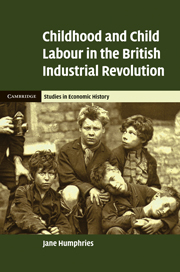4 - Household economy
Published online by Cambridge University Press: 06 December 2010
Summary
Introduction
Chapter 3 demonstrated that in terms of size and structure, the frequency with which they were extended, and the kinds of non-nuclear kin admitted, the autobiographers' families fit demographic expectations. There were also surprises: the extent of fatherlessness, the prevalence and origins of lone-mother households and the multifaceted reasons for household extension, suggesting more complex readings of duty and reward than conveyed in standard ideas about exchange and reciprocity. This chapter turns to the economic circumstances of these same families. Were they, too, typical, and, if so, how did material conditions influence the supply of child labour?
The autobiographies do not contain the kind of systematic information needed to construct indices of real wages or family incomes. But occasional evidence on the occupations and earnings of husbands and fathers can be compared with standard accounts of the male labour force and men's wages in order to check that low-paid occupations or low-paid men within those occupations are not over-sampled, thereby presenting an unduly gloomy picture. Going further, by capturing the division of labour within families and relative contributions of different family members to family income, the autobiographies provide perspective on men's jobs and wages.
Although historians have paid lip-service to the need to look beyond men's earnings and include the contributions of other family members, self-provisioning and poor relief in computations of family incomes, practical efforts in this direction are rare.
- Type
- Chapter
- Information
- Publisher: Cambridge University PressPrint publication year: 2010

